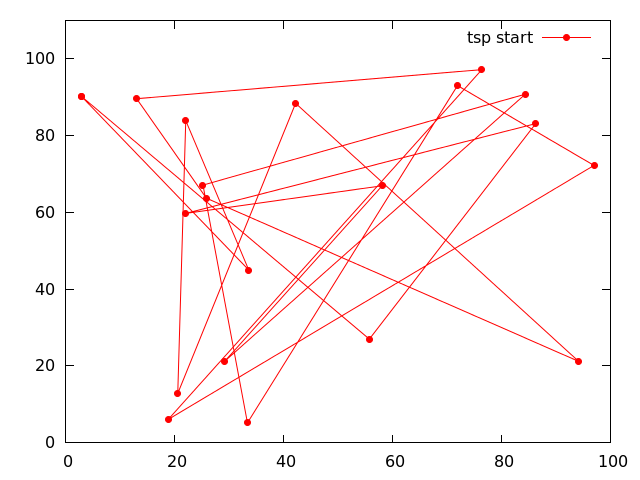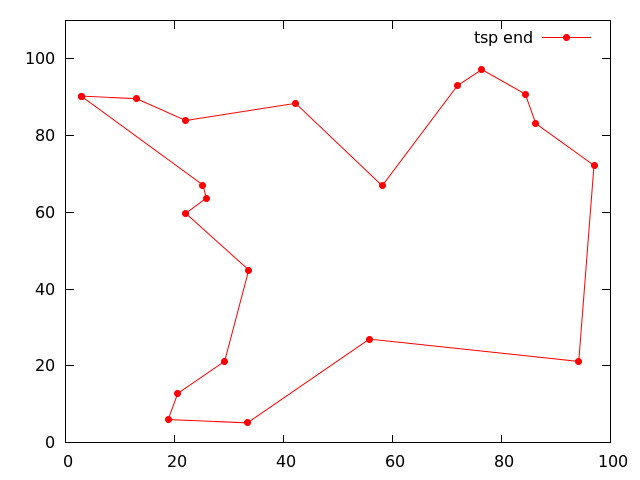5 releases (3 breaking)
Uses old Rust 2015
| 0.4.0 | Jun 26, 2017 |
|---|---|
| 0.3.0 | Aug 29, 2016 |
| 0.2.0 | Aug 16, 2016 |
| 0.1.1 | Jun 12, 2016 |
| 0.1.0 | Jun 11, 2016 |
#2419 in Algorithms
44KB
467 lines
darwin-rs
This library allows you to write evolutionary algorithms (EA) using the Rust programming language.
Written by Willi Kappler, License: MIT - Version 0.4 (2017.06.26)
Documentation: darwin-rs


The example folder contains these examples:
- TSP (traveling salesman problem): the classic type of problem for EA (see two pictures above).
- Sudoku: a sudoku solver using EA.
- Queens: solving the queens problem with EA. Although not as fast as this one ;-)
- OCR: a simple optical character recognition example. Two strings are drawn (rendered) using a truetype font on a image buffer and then a perfect match representing the drawn text is found.
darwin-rs uses semantic versioning
Usage:
Add the following to the Cargo.toml in your project:
[dependencies]
darwin-rs = "0.4"
And this in the rust source code of your application:
extern crate darwin_rs;
use darwin_rs::{Individual, SimulationBuilder, Population, PopulationBuilder, SimError};
Basically you have to implement the trait Individual for your data structure:
#[derive(Debug, Clone)]
struct MyStruct {
text: String
}
impl Individual for MyStruct {
fn mutate(&mut self) {
// Mutate the struct here.
...
}
fn calculate_fitness(&mut self) -> f64 {
// Calculate how good the data values are compared to the perfect solution
...
}
fn reset(&mut self) {
// Resets all the data for this individual instance.
// This is done to avoid getting stuck in a local minimum.
...
}
}
These three methods are needed:
mutate(&mut self): Mutates the content of the struct.
calculate_fitness(&mut self) -> f64: This calculates the fitness value, that is how close is this individual struct instance to the perfect solution ? Lower values means better fit (== less error == smaller distance from the optimum).
reset(&mut self): Resets all the data after a specific number of iteration (see reset_limit), to avoid local minima.
There is one more method (new_fittest_found) but it is optional and the default implementation does nothing.
If you want to share a large data structure between all the individuals you need Arc, see TSP and OCR examples.
Now you have to create one or more populations that can have different properties:
// A helper function that creates a vector of individuals of your data structure:
let my_pop = make_population(100);
let population1 = PopulationBuilder::<MyStruct>::new()
.set_id(1)
.initial_population(&my_pop)
.increasing_exp_mutation_rate(1.03)
.reset_limit_increment(100)
.reset_limit_start(100)
.reset_limit_end(1000)
.finalize().unwrap();
let population2 = PopulationBuilder::<MyStruct>::new()
.set_id(2)
.initial_population(&my_pop)
.increasing_exp_mutation_rate(1.04)
.reset_limit_increment(200)
.reset_limit_start(100)
.reset_limit_end(2000)
.finalize().unwrap();
set_id(): Sets the population ID. This can be any positive u32 integer. Currently this is only used for internal statistics, for example: which population does have the most fittest individuals ? This may help you to set the correct parameters for your simulations.
initial_population(): This method takes a vector of individuals. The best practice is to use a helper function, see examples.
increasing_exp_mutation_rate(): Sets the mutation rate for each individual: Use exponential mutation rate.
reset_limit_increment(): Increase the reset limit by this amount every time the iteration counter reaches the limit
reset_limit_start(): The start value of the reset limit.
reset_limit_end(): The end value of the reset limit. If this end value is reached the reset limit is reset to the start value above.
Alternatively you can also put all the populations inside a vector.
After that you have to create a new instance of the simulation and provide the settings:
let my_builder = SimulationBuilder::<MyStruct>::new()
.factor(0.34)
.threads(2)
.add_population(population1)
.add_population(population2)
.finalize();
match my_builder {
Err(SimError::EndIterationTooLow) => println!("more than 10 iteratons needed"),
Ok(mut my_simulation) => {
my_simulation.run();
println!("total run time: {} ms", my_simulation.total_time_in_ms);
println!("improvement factor: {}", my_simulation.simulation_result.improvement_factor);
println!("number of iterations: {}", my_simulation.simulation_result.iteration_counter);
my_simulation.print_fitness();
}
}
factor(): Sets the termination condition: if the improvement factor is better or equal to this value, the simulation stops.
threads(): Number of threads to use for the simulation.
add_population(): This adds the previously created population to the simulation.
finalize(): Finish setup and do sanity check. Returns Ok(Simulation) if there are no errors in the configuration.
add_muliple_populations(): Allows you to add all the populations inside a vector in one method call.
Then just do a match on the result of finalize() and call simulation.run() to start the simulation. After the finishing it, you can access some statistics (total_time_in_ms, improvement_factor, iteration_counter) and the populations of course:
for population in my_simulation.habitat {
for wrapper in population.population {...}
}
Each individual is wrapped inside a Wrapper struct that contains additional information needed for the simulation: fitness and the number of mutations.
See also the example folder for full working programs.
Discussion:
Used crates:
- jobsteal: parallelization
- error-chain: easy error handling
- log: use logging mechanism instead of
println!()
Similar crates:
- genetic-files
- RsGenetic
- evo-rs
- calco-rs
- GenGen
- parasailors
- random-wheel-rs
- roulette-wheel-rs
- differential-evolution-rs
- evolve-sbrain
- Nodevo
Any feedback is welcome!
Dependencies
~3–8.5MB
~79K SLoC